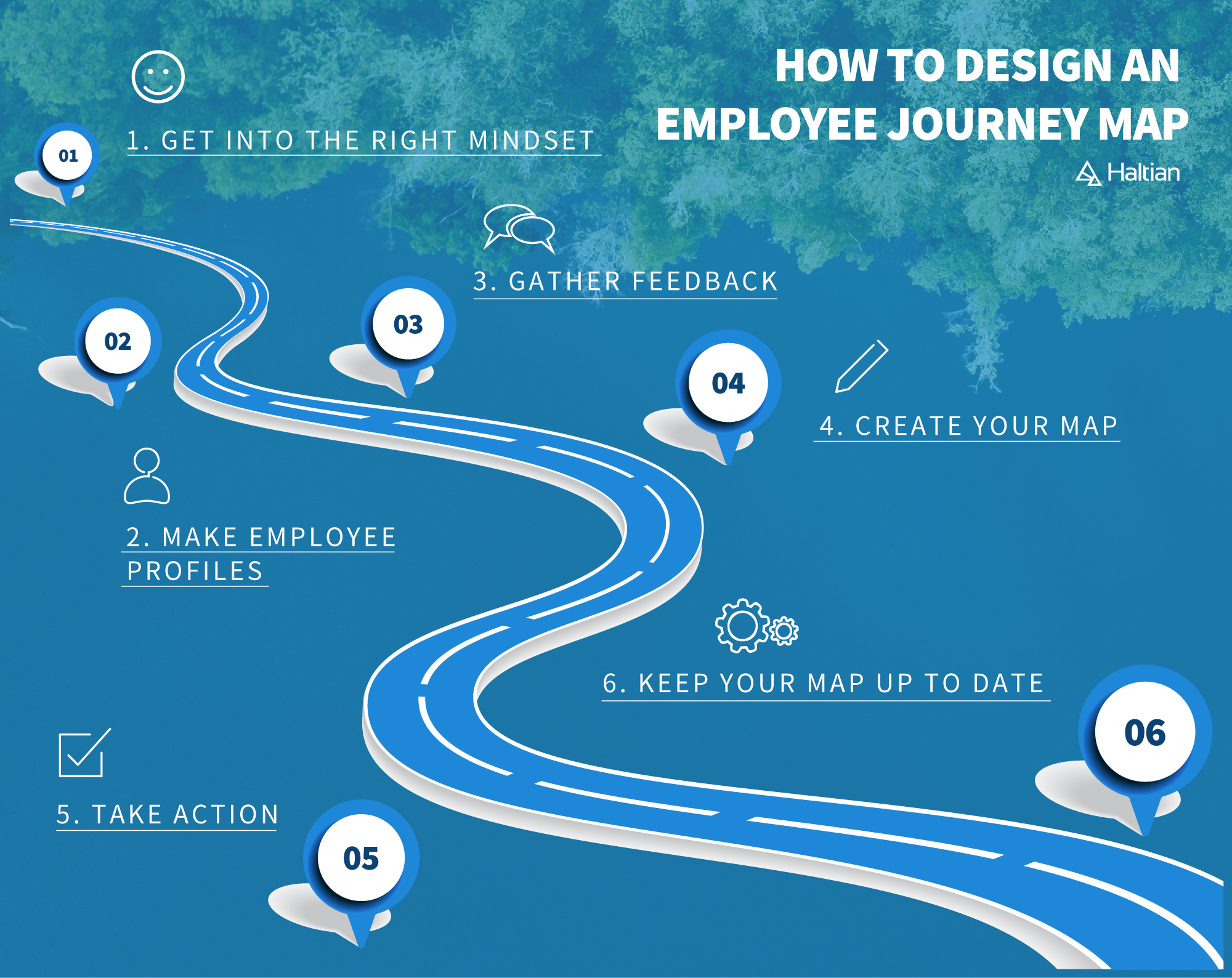How to design an employee journey map
Putting your employees first and focusing on employee experience has become a critical task for companies. The benefits of focusing on employee experience are becoming widely known, but many HR professionals and company leaders struggle with where to start in improving their employee experience.
One way is to design an employee journey map, with steps and action plans for every stage of your employees’ journey. With the help of this infographic, you’ll learn how to design an employee journey map.

What is an employee journey map?
As TechTarget writes: “At its simplest, an employee journey map is a graphical image that represents the organizational path, or moments that matter, for a particular type of employee.” It includes all the different steps, touchpoints, and feelings an employee experiences during their time at your company, and even after they have left.
It also includes communication and action plans for each stage, so creating a better employee experience becomes easier for you.
Employee journey mapping is a great way to be proactive, improving the employee experience as you can map out the key stages and experiences in the employees’ journey.
What does an employee journey map look like?
You can make your company’s employee journey maps in many different ways. Some have very simple and straightforward maps, some have more color and perhaps even a story to go with the journey. The main thing is to create a map that benefits you the most.
There are many kinds of mapping templates and tools, for example, creately or Vengage Map Maker.
What are the benefits of creating an employee journey map?
The main reason for making an employee journey map is to increase employee experience: by writing down the different experiences and feelings, you can maximize the good moments, and minimize any possible bad moments. If you want to read more about the benefits of increasing employee experience, check out this handy infographic.
1. Get into the right mindset
To begin designing your employee journey map, ask yourself why you want to create the journey map and define clear goals. This way you can create the right kind of map for your needs. Don’t assume to know it all, and be open to different perspectives, and feedback and listen to many viewpoints to get a more objective picture of your employees’ journeys.
2. Gather feedback
The best way to get to know your employees is to ask them directly. You can have interviews or, for example, create an employee survey to identify the different touch points and the feelings employees experience. Remember to ask not just your current employees, but previous ones as well. Perhaps some who changed to a different company or retired recently.
As previously mentioned, do not assume anything during the process. Conduct employee experience research, and combine that with data you already have, such as turnover rates, tenure statistics, and exit interview details.
3. Segment your employees
Designing an employee journey map is very much like designing a customer journey map. And like every sales and marketing person knows, you get the best results by knowing your audience. This is easiest done by segmenting your employees into employee personas.
Like a customer persona, an employee persona maps out the goals, obstacles, pain points, and some of the workplace behaviors of the employee. An employee persona is an imaginary representation of a typical employee, and usually, a company has a couple of different personas to create a more individual employee journey.
The details in the persona usually include an age range, job profile, motivations, biggest issues, and workplace behaviors, like if a person is more of an extrovert or an introvert.
4. Create your journey map & define the moments that matter
Now you know what an employee journey map is, why you should create one and you have a couple of employee profiles ready to go. To design one, you need to ask yourself what are the different stages an employee has during their time working, what are their goals in each step and how do they feel?
Typically, the stages of an employee journey include:
- Recruiting
- Onboarding
- Education
- Promotion
- Relocation
- Personal events
- Knowledge transfer
- Exit of the company
- Retirement
For all these stages, you also need to design
- Communication plan: how, where, and who communicates with the employee?
- Feedback plan: who gives feedback, where, and how often? Also, when can the employee give feedback?
- Recognition plan: map out opportunities and stages to give recognition for s job well done.
- Employee development plan: how will you support the employee’s professional development?
- Engagement plan: how do you increase the feeling of purpose and belonging?
It is important to define the moments that matter the most to your company and start working from them. These could be anything, for example, focusing on the onboarding process or having coaching sessions with the supervisors.
5. Take action
The map is of no use if it does not lead to action. Now that you have a clear action and communication plan for each step of an employee’s journey, it’s time to start implementing them by discussing them with HR, managers, department heads and other possible stakeholders.
To make the employee journey map useful in practice, you need to break down the responsibilities for the action plan. Break down the work into smaller pieces and divide responsibility among multiple teams and team members.
Defining measurements for each of the journey stages is very important. It allows for scaling the process and improving it constantly.
6. Keep your employee journey map up to date
Your employee journey will always be changing, so your map should too. Take major changes and events into consideration, keep asking for feedback periodically, and update your map accordingly.
Feedback from employees and data from other sources helps you keep on top of the issues in your company and allows for improving your employee experience.
Parting words and next steps
Here, you have the steps for how to design an employee journey map, so that you can create the best possible employee experience, increase engagement, and have happy employees! The next obvious step is, of course, to start mapping.
- Think of the goals for the map and get into the right mindset
- Make some employee profiles
- Get feedback and ask around
- Write down all the touchpoints and create your map
- and always keep your map up to date
We all need inspiration from time to time, read this article where we have listed six examples of great employee experience for you to get inspiration from:

Examples of great employee experience
Get inspired with these examples!


